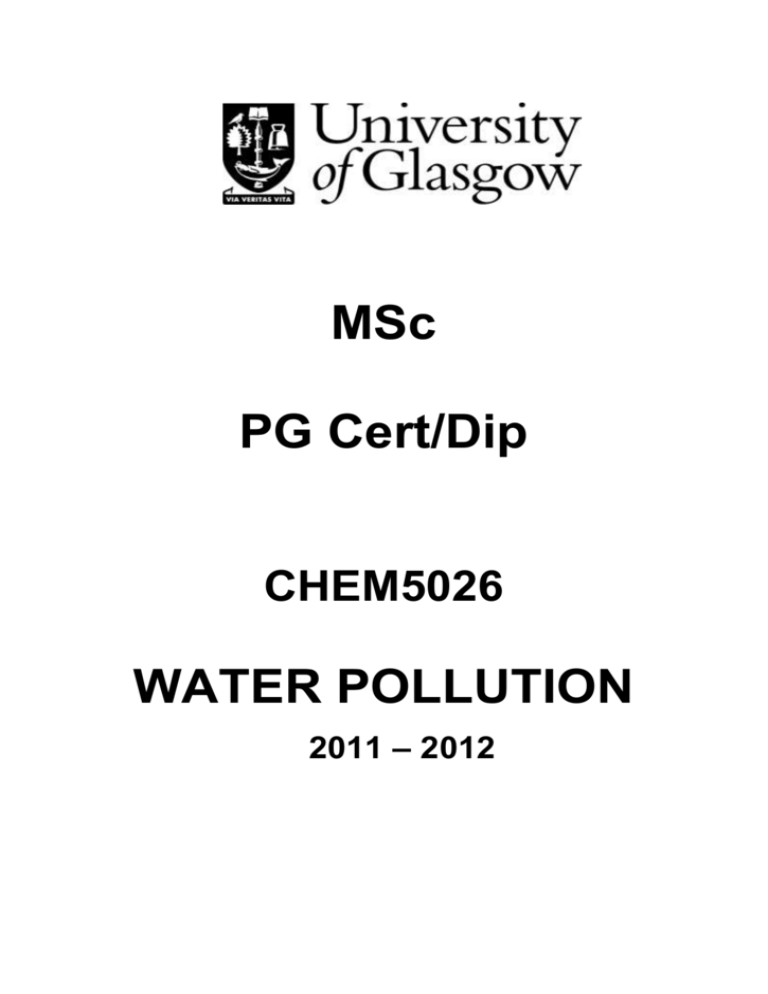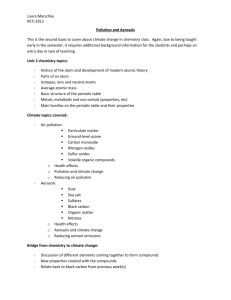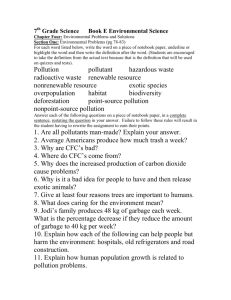Water Pollution - University of Glasgow
advertisement

MSc PG Cert/Dip CHEM5026 WATER POLLUTION 2011 – 2012 Department: Building location: Title of Course: Course Code: Chemistry Department, University of Glasgow Joseph Black Building, University of Glasgow Water Pollution GU915 Course Details Module Organiser: Dr. T. H. Flowers Room C5-05 Joseph Black Building Tel Ext. 5952 E-mail: hughf@chem.gla.ac.uk Other Lecturers: Dr C.D. McPhail, Scottish Environment Protection Agency Dr A. Hills, Scottish Environment Protection Agency Lectures: 1pm on Monday, Tuesday, Thursday and Friday. Room A5-04 Joseph Black Building Friday 3th February to Friday 17th February (2 weeks) 10am – 1 pm Friday Room C4-07 Joseph Black Building Friday 13th January to Friday 10th February (5 Fridays) Laboratories: Room C5-09 Joseph Black Building At times to be arranged Field trips: at times to be arranged Level: PG Credit value: 20 credits Class website The address of the class website is www.chem.gla.ac.uk/environment. It can also be accessed from the Chemistry Department website via Moodle. Class notices and downloadable course material will be posted on this site. Copies of some lecture handouts are available on the website in a read-only format. Note: these are not complete lecture notes and should be used only to back up notes taken in lectures. The laboratory data will also be available. This material is held within a area of the website restricted to registered class members Module Overview & Learning Outcomes Module Overview: This module provides a thorough introduction to the study of water pollution in a river system. It will be taught in the Environmental Chemistry laboratories at the University of Glasgow. Using a combination of lectures, field work, laboratory analysis and background research, the module is an in-depth study of the forms and sources of water pollution in the River Kelvin and its tributaries. It will provide training in environmental sampling, chemical analysis, data handling, interpretation of data in relation to regulatory requirements and project report writing. Learning Outcomes – Lectures (23 hours) Title: Water Pollution Duration: THF - 8 lectures Aims: To provide an understanding of the effects of water pollution in fresh water and marine waters. Objectives: At the end of this module students should have an understanding of the following: Sources of water pollution; point sources Vs diffuse sources; types of pollutants; the red list; national and European Legislation. BOD; dissolved oxygen measurement; chemistry of titrimetric and polarographic methods for oxygen measurement; COD, TOC and the chemistry of their measurement; nitrogen and phosphorus measurement. Sewage treatment; composition, primary, secondary and tertiary treatment; sludge disposal; quality criteria for discharge water and environmental impact. Eutrophication; sources of N and P; impacts. Leaching of nitrate form agricultural land; fertilizer use and effects of cropping; groundwater pollution by nitrate and possible solutions. Drinking water quality; sources of drinking water; nitrate in drinking water, methaemoglobinaemia, cancer risks; EC guidelines; variations with agricultural practice. Lead in drinking water, chemistry and EC guidelines. Title: Water Pollution Lecturers: Dr Calum D. McPhail and Dr Alan Hills, SEPA Aims: To understand the systems and framework currently used for controlling pollution to water environments in Scotland, with particular reference to the role and duties of the Scottish Environment Protection Agency (SEPA) using examples of pollution inputs and effects monitoring. Intended learning outcomes: 1. At the end of this series of lectures, students should be able to: Describe the overall regime in Scotland for regulating pollution to controlled waters and of the work of the Scottish Environment Protection Agency (SEPA) – mainly background to current powers and duties relevant to the water environment. 2. Describe the basic legal framework that underpins pollution control in the water environment - from EU primary Directives, implementation into legislation by member states (Scotland) and of detail from examples in current Regulations. 3. Explain the pollution regulatory and environmental monitoring regimes required to support environmental effects monitoring and improvement plans – surface and marine waters. 4. Describe the role of the Water Framework Directive and of likely changes in monitoring and assessment techniques. 5. Pollution studies 1. Using examples, describe and explain the polluting effects arising from direct discharges to surface waters (rivers, lochs), consideration of diffuse pollution and nutrients, methods of assessing environmental quality and ecological status. Work with an example of assessing an acceptable environmental impact from a new polluting input – discharge consent calculation. 6. Pollution studies 2. Describe and explain chemical and biological effects, which may arise from polluting inputs from fish farms, both to surface (freshwater) and marine waters. 7. Case studies 1. Describe pollution risk assessment and improvement plans to achieve improved water quality, examples of bathing waters improvement plan, river flow and load river transport assessment, role of diffuse pollution, practical examples of pollution incidents. 8. Case studies 2. Describe measures taken to protect the marine environment; Practical aspects of survey design, environmental monitoring, data assessment and reporting; Case studies for monitoring in respect of the EC Dangerous Substances, Shellfish Waters and Urban Waste Water Treatment Directives; Statistical analysis of data; Assurance of data quality; Integration of chemical, hydrographic and biological data 9. Pollution studies 3. Describe mixing processes in estuaries and coastal waters; Design surveys to establish sources, impacts and fate of potential pollutants; Critically assess and interpret environmental monitoring data; Carry out environmental assessment from cradle to grave (i.e. from identification of the problem through survey design to data assessment and reporting) Learning outcomes laboratory and project work i) Aims and Objectives Learning outcomes: Upon successful completion of this module, the student will be familiar with: The principles and practice of sampling river water. The use of simple field tests for water analysis. The principles and practice of the techniques used for the laboratory analysis of river water. The manipulation of a large data set. The comparison of analytical data obtained using different techniques. The integration of field observations and laboratory measurements to identify types and sources of pollution. The wider issues of river pollution from background reading. The presentation of a complex set of disparate scientific data in an appropriate form for both expert and non-expert readers. ii) Content and Curriculum The work of the module is carried out in the field and laboratory as follows: a) b) Field work – 1 day: Location of sampling site using GPS and OS maps. Collection of river water samples. Measurement of pH using field meters. Measurement of conductivity using field meters. Measurement of turbidity using field meters. Measurement of dissolved O2 concentration using field meters. Measurement of dissolved N, P, S, Cl using field colorimetry. Laboratory work – 18 hours Measurement of: Suspended solids – gravimetric. Suspended solids – turbidimetric. pH. Conductivity. Oxygen saturation – O2 electrode. Oxygen saturation – Winkler titration. Biochemical Oxygen Demand (BOD5). Chloride concentration by electrochemical method. Sodium and potassium by atomic emission spectroscopy. Calcium and magnesium by atomic absorption spectroscopy. Nitrite and soluble reactive phosphate by colorimetry. Nitrate and ammonium by steam distillation. Ammonium by electrochemical analysis. Ammonium, nitrate, nitrite and soluble reactive phosphate by automated colorimetry. Anions by ion chromatography. c) d) Post-laboratory fieldwork (4 hours) Tour of river Kelvin catchment.) Interpretation of laboratory results in relation to field observations. Seminars – 4 hours Assessment This is a 100% continual assessment class. Students will be assessed on the basis of: Laboratory work (20%) Project report (75%) Field work (5%) A detailed briefing for the project report will be provided in a tutorial session Reading 1. Specific Information on the Kelvin Catchment Turner A K and Barr C L. (1989) River Pollution: a case study. Glasgow University, 1989. Available in Chemistry Branch Library. Clyde River Purification Board Annual Reports. Full set held in the main library, the last two reports are in the Chemistry Branch Library. Clyde River Purification Board (1985). Water Quality- a Ten Year Review 1976-1985. A report on rivers, tidal waters and effluents in the area of the Clyde River Purification Board. CRPB, 1985. Available in Chemistry Branch Library. Scottish Environment Protection Agency (2000) West Region Water Quality Review Interactive CD ROM. Available in Chemistry Branch Library. Current information is available on the SEPA Web Site www.sepa.org.uk 2. More General Reading Some aspects of the course are not adequately covered in any textbook. Therefore attendance at lectures is vital, more so than in most other courses. The following are suitable for more general reading and reference. They are available in Chemistry Branch Library. All are well indexed. Cunnigham W P Cunningham M A and Saigo B W. (2008) Environmental Science a Global Concern. 10th edition, McGraw Hill 2008. Chapter 18 Water Pollution. Harrison R M (editor) (2001) Pollution causes effects and control. 4th Edition, RSC 2001 Chapters 1 to 5 relate to water pollution. Bronmark C and Hansson L (2005) The Biology of Lakes and Ponds. 2nd edition. Oxford University Press 2005. The following websites provide useful background material on water pollution. www.sepa.org.uk www.environment-agency.gov.uk www.scottishwater.co.uk www.defra.gov.uk The following textbooks are recommended. Environmental Chemistry at a Glance. Blackwell Publishing, 2006 An Introduction to Environmental Chemistry. Andrews, J.E., Brimblecombe, P., Jickells, T.D., Liss, P.S. and Reid, B.J. Blackwell Publishing, 2004. Pulford, Ian and Flowers, Hugh. The following textbooks may be useful for consultation for different parts of the course. All are available on short loan in the Chemistry Branch Library. Principles of Environmental Chemistry. R.M. Harrison (Ed), Royal Society of Chemistry, 2007. An Introduction to Pollution Science. R.M. Harrison (Ed), Royal Society of Chemistry, 2007. Environmental Chemistry. O’Neill P. Chapman Hall 3rd edition 1998 Environmental Chemistry. Manahan S E. Lewis Publishers 7th edition 2000 Introductory Chemistry for the Environmental Sciences. R M Harrison et al. Cambridge University Press 2nd edition 1996






